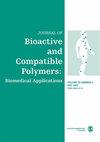骨增强用丝素颗粒聚乙烯醇导骨水凝胶支架:结构形成和体外试验
IF 2.1
4区 生物学
Q3 BIOTECHNOLOGY & APPLIED MICROBIOLOGY
引用次数: 0
摘要
骨增强术是治疗颌面部骨质流失的一种有效方法。本研究制备了具有丝素蛋白颗粒(SFP)的聚乙烯醇(PVA)导骨水凝胶支架。SFP是通过将丝素蛋白溶液滴入丙酮中形成的,以不同体积比(v/v)的丝与丙酮:1:3 (SFP-3), 1:6 (SFP-6), 1:12 (SFP-12)和1:24 (SFP-24)。在通过冷冻解冻制成水凝胶之前,将各种SFP溶液与PVA溶液混合。然后,将水凝胶冷冻干燥制成支架。利用动态光散射、傅里叶变换红外光谱、差示扫描量热法和扫描电子显微镜(SEM)对SFP的粒径、电荷、分子结构和形貌进行了表征和观察。用扫描电镜观察了水凝胶支架的形态。用溶胀率评价水凝胶支架的溶胀行为。并对其力学性能进行了测试。用成骨细胞培养支架,检测支架的生物学性能、细胞活力和性能、碱性磷酸酶活性、钙沉积和总蛋白。其中,SFP-24的粒径最小。含有SFP-24的PVA水凝胶支架具有颗粒聚集性低、支架内颗粒分布良好、溶胀率低的特点。添加SFP的PVA水凝胶支架比不添加SFP的支架具有更高的机械稳定性。此外,含有SFP-24的PVA水凝胶支架具有更好的生物性能。最后,实验结果表明,含有SFP-24的PVA水凝胶支架具有良好的骨传导性能,在骨增强方面具有广阔的应用前景。本文章由计算机程序翻译,如有差异,请以英文原文为准。
Osteo-conductive hydrogel scaffolds of poly(vinylalcohol) with silk fibroin particles for bone augmentation: Structural formation and in vitro testing
Bone augmentation is an effective approach to treat patients who have bone loss at the maxillofacial area. In this research, osteo-conductive hydrogel scaffolds of poly(vinylalcohol) (PVA) with silk fibroin particles (SFP) were fabricated. The SFP were formed by dropping a solution of silk fibroin into acetone at different volume ratios (v/v) of silk to acetone: 1:3 (SFP-3), 1:6 (SFP-6), 1:12 (SFP-12), and 1:24 (SFP-24). The various SFP solutions were mixed with a PVA solution before fabrication into hydrogels by freeze-thawing. Afterwards, the hydrogels were freeze-dried to fabricate the scaffolds. The particle size and charge, molecular organization, and morphology of the SFP were characterized and observed with dynamic light scattering, Fourier transform infrared spectroscopy, differential scanning calorimetry, and scanning electron microscopy (SEM). The morphologies of the hydrogel scaffolds were observed with SEM. Swelling percentage was used to assess the swelling behavior of the hydrogel scaffolds. The mechanical properties were also tested. The scaffolds were cultured with osteoblast cells to test the biological performance, cell viability and performance, alkaline phosphatase activity, calcium deposition, and total protein. The SFP-24 was the smallest in particle size. PVA hydrogel scaffolds with SFP-24 demonstrated low particle aggregation, good particle distribution within the scaffold, and a lower swelling percentage. PVA hydrogel scaffolds with SFP had higher mechanical stability than scaffolds without the SFP. Furthermore, the PVA hydrogel scaffold with SFP-24 had better biological performance. Finally, the results demonstrated that PVA hydrogel scaffolds with SFP-24 showed good osteo-conductive performance which is promising for bone augmentation.
求助全文
通过发布文献求助,成功后即可免费获取论文全文。
去求助
来源期刊

Journal of Bioactive and Compatible Polymers
工程技术-材料科学:生物材料
CiteScore
3.50
自引率
0.00%
发文量
27
审稿时长
2 months
期刊介绍:
The use and importance of biomedical polymers, especially in pharmacology, is growing rapidly. The Journal of Bioactive and Compatible Polymers is a fully peer-reviewed scholarly journal that provides biomedical polymer scientists and researchers with new information on important advances in this field. Examples of specific areas of interest to the journal include: polymeric drugs and drug design; polymeric functionalization and structures related to biological activity or compatibility; natural polymer modification to achieve specific biological activity or compatibility; enzyme modelling by polymers; membranes for biological use; liposome stabilization and cell modeling. This journal is a member of the Committee on Publication Ethics (COPE).
 求助内容:
求助内容: 应助结果提醒方式:
应助结果提醒方式:


